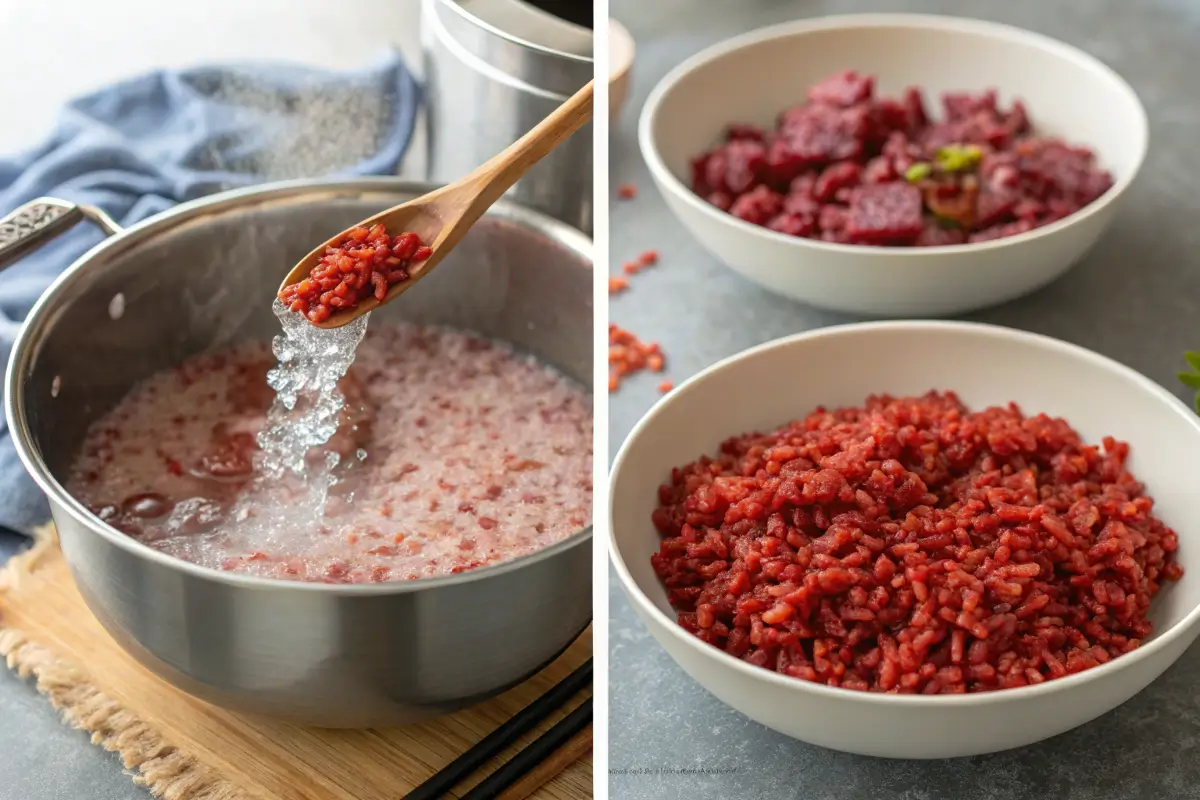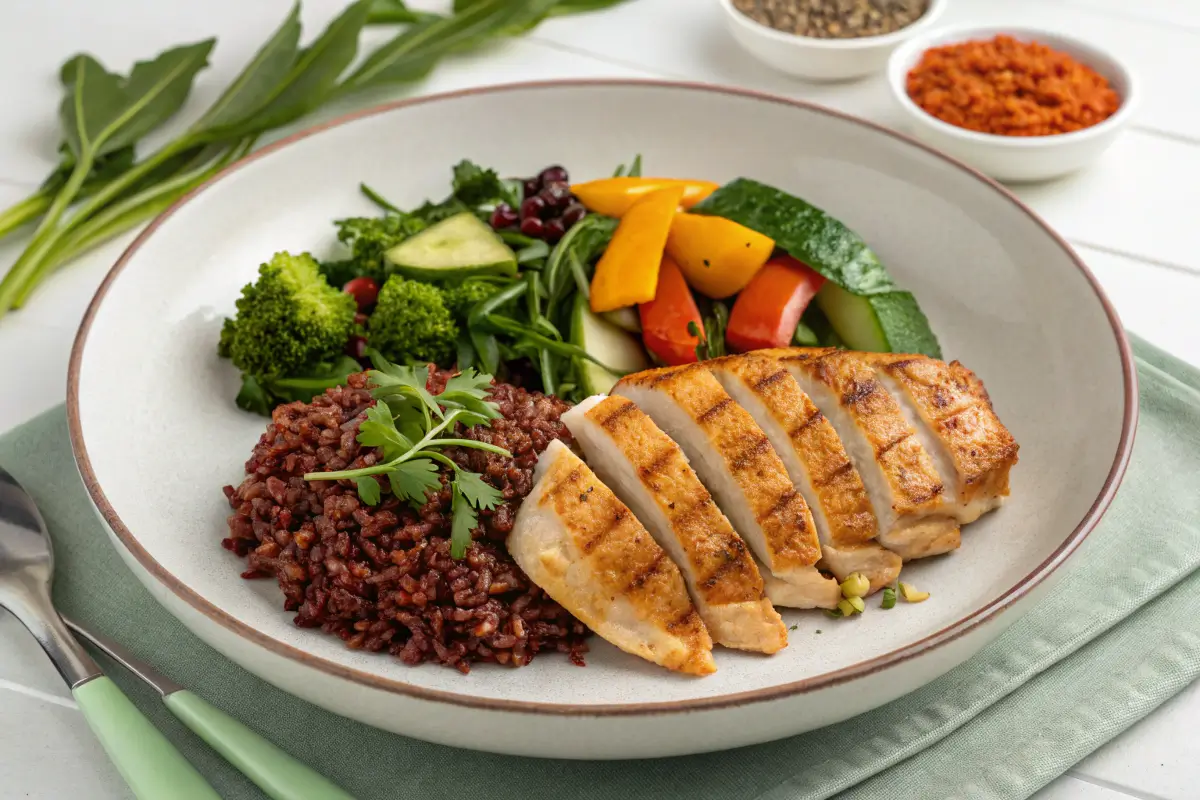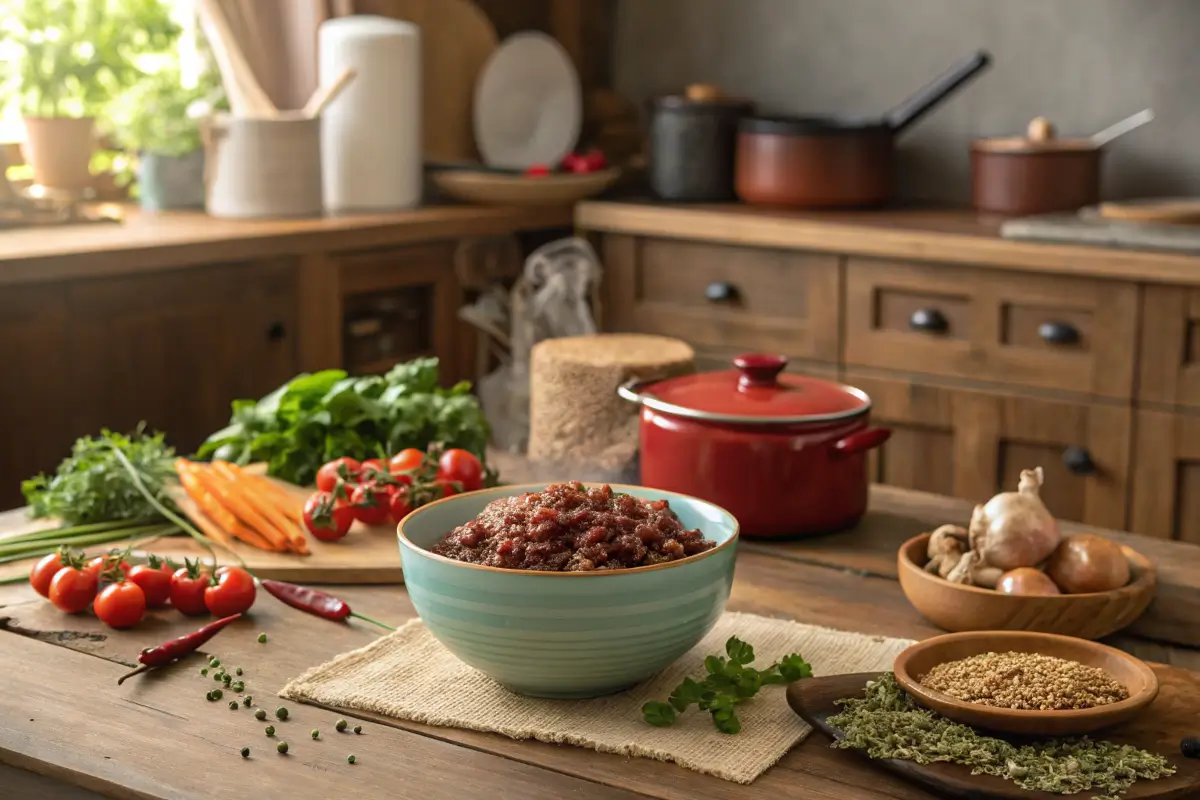Red rice is much more than a regular rice variety—it’s a vibrant, nutrient-rich ingredient that’s as versatile as it is delicious. This guide dives deep into everything you need to know about this whole grain, including its origins, how it’s prepared, and its many uses in cooking. We’ll explore its cultural significance, provide step-by-step cooking tips, and share recipes to inspire you in the kitchen. Whether you’re new to this grain or a long-time fan, this comprehensive guide will show you why it deserves a spot in your pantry.
Introduction to Red Rice
What is Red Rice?
This rice variety stands out with its reddish-brown hue, attributed to anthocyanin pigments in its outer layer. Unlike white rice, which undergoes polishing that strips away its bran, red rice retains its nutritious covering, making it a healthier alternative. Its nutty flavor and chewy texture add depth and heartiness to any meal.
The distinctive reddish color isn’t just for show—it’s a sign of the grain’s antioxidant content, which makes it a popular choice among health-conscious individuals. It offers a unique flavor and texture that enhance a variety of dishes.
Why Choose Red Rice? Nutritional and Cultural Importance
This type of rice isn’t just a flavorful addition to your meals; it’s also a nutritional powerhouse. Packed with fiber, iron, and magnesium, it supports digestion, boosts energy, and promotes heart health. It has been a dietary staple in traditional cuisines across Asia, Africa, and the southern United States, where cooks use it to prepare everything from biryanis to pilafs.
From the rich, spiced gravies of India to the classic Charleston-style recipes of the American South, this grain reflects culinary heritage and creativity. Its growing popularity aligns with a global demand for wholesome ingredients and authentic flavors.
Origins and Varieties of Red Rice
Historical Background of Red Rice
This grain boasts a history spanning thousands of years in regions like Asia and Africa. It has long been a dietary staple for communities where rice cultivation plays an essential role in daily life. Countries such as India, Sri Lanka, and Bhutan value it for its nutritional richness and cultural importance. Farmers in these areas have traditionally relied on natural farming methods to produce this nutrient-dense crop.
Throughout history, this variety of rice has symbolized prosperity and health. Ancient medicinal recipes often included it for its perceived healing properties. Today, its popularity is on the rise, driven by global interest in whole grains and superfoods.
Varieties of Red Rice Across the World
This unique rice variety offers many types, each with distinctive flavors and textures. For example, Bhutanese red rice is semi-milled, cooks quickly, and features a slightly nutty flavor. Kerala Matta rice, grown in southern India, is heartier and commonly used in traditional recipes like biryani and idlis.
Other examples include Camargue red rice from France, known for its aromatic and sticky qualities, and African red rice, prized for its earthy taste and hearty texture. Each variety reflects its region’s farming techniques and culinary traditions, making this grain incredibly versatile.
Pro Tip: Learn to cook red rice to bring out its distinct flavors by visiting this red rice recipe guide.
How Red Rice is Processed
From Harvest to Milling
Ever wondered how this unique grain is cultivated? The process starts with careful harvesting in regions with abundant water sources, such as river deltas. Once mature, the grains are sun-dried to prepare them for further steps. Unlike white rice, this variety undergoes minimal milling, allowing it to retain its bran and germ layers, which are packed with nutrients.
The semi-polishing process preserves the anthocyanins that give the grain its distinctive reddish hue. This method enhances its health benefits and imparts a unique flavor and texture. Since the grain is less processed, it takes longer to cook, but the resulting dish is worth the wait due to its superior nutritional profile.
Difference Between Red Rice and Other Types
This whole grain sets itself apart from other varieties with its rich nutritional content and robust flavor. Compared to white rice, it contains more fiber, antioxidants, and essential minerals like magnesium and iron. While it shares some similarities with brown rice, its nutty taste and chewier texture make it a standout choice for hearty meals. Its vibrant red color also adds a pop of visual appeal to any dish, making it as attractive as it is healthy.
For an easy and healthy meal idea, explore this guide to pairing red rice with protein-packed dishes.
Cooking Methods for Red Rice
Preparing Red Rice: Basic Steps

Cooking this whole grain may seem intimidating at first, but once you grasp the basics, it’s as simple as preparing other grains. Transforming it into the fluffy, nutty dish we all love involves just a few key steps:
- Rinse Thoroughly: Wash the grains under cold water to remove natural starch and debris. Continue until the water runs clear.
- Soak (Optional): Although optional, soaking for 30 minutes can cut down cooking time and improve texture.
- Boil and Simmer: Use a 1:2 ratio of grains to water. Bring the water to a boil, add the grains, then lower the heat to a simmer. Cover the pot and cook for 40-50 minutes.
Once done, fluff it with a fork and allow it to rest for a few minutes before serving.
Popular Cooking Methods Across Cultures
Various cultures approach this grain with unique cooking methods. Some of the most common include:
- Pressure Cooking: A time-saving method, pressure cooking preserves the grain’s nutrients while reducing the cooking duration.
- Steaming: A popular technique in many Asian cuisines, steaming maintains the natural flavor and is ideal for pairing with stir-fries or curries.
- Pilaf Method: Sauté the grains in oil or butter with spices before adding water, creating a fragrant and flavorful dish.
To explore ways to pair it with delicious main courses, check out this red rice recipe guide.
Common Mistakes and How to Avoid Them
If you’re new to this grain, it’s easy to make mistakes, but they’re simple to avoid:
- Skipping Rinsing: Failing to rinse can result in sticky or clumpy grains.
- Incorrect Water Ratio: Too little water leads to undercooked rice, while too much makes it mushy.
- Rushing the Process: Unlike white rice, this variety requires patience, as it takes longer to cook.
Mastering these basics ensures your grain turns out perfect every time, whether you’re using traditional or modern cooking methods.
Recipes Featuring Red Rice
Traditional Recipes for Red Rice
Among traditional dishes, Charleston-style rice takes center stage. This Southern favorite combines grains with tomatoes, onions, and bell peppers, simmered in a smoky broth with bacon or sausage. It’s a comforting and flavorful dish that reflects the heart of Southern cooking.
In India, this whole grain shines in biryanis and curries, where its nutty flavor pairs beautifully with spiced gravies. In Sri Lanka, people enjoy it as a staple served alongside lentil curry, coconut sambal, and crispy fried fish.
If you’re looking to try these timeless recipes, check out this guide to cooking authentic dishes.
Modern Fusion Dishes Featuring Red Rice
This versatile grain has also become a favorite in modern kitchens, inspiring innovative fusion recipes. Chefs and home cooks are creating exciting dishes that blend traditional flavors with contemporary twists. Here are a few ideas to try:
- Buddha Bowl Delight: Pair cooked grains with roasted vegetables, avocado, and a creamy tahini dressing for a vibrant, nutrient-packed meal.
- Southwest Black Bean Salad: Combine these grains with black beans, sweet corn, and a tangy citrus vinaigrette for a refreshing side dish or light meal.
- Stuffed Peppers with a Twist: Use the grains as a filling for bell peppers along with ground meat, fresh herbs, and cheese for a hearty, oven-baked dish.
These recipes showcase the versatility of this nutritious ingredient, allowing you to explore both its traditional roots and its potential for modern culinary creations.
For more ideas on incorporating red rice into everyday meals, explore other recipes on the site, like this guide on side dishes.
FAQs About Red Rice
How is red rice different from other rice?
Red rice has a different processing and nutritional profile compared to white and brown rice. White rice undergoes polishing that removes its bran, but red rice keeps its outer layer intact. This difference gives red rice its chewy texture and earthy flavor. It also delivers antioxidants, fiber, and minerals, making it a healthier choice. If you’re curious about how red rice is made, its minimal processing plays a key role in preserving its natural goodness.
Can red rice be used in desserts?
Yes! Red rice is versatile enough to be used in desserts. For example, you can make a red rice pudding by cooking it with coconut milk, sugar, and cardamom. Its nutty taste pairs well with sweet ingredients, offering a unique twist to traditional rice-based desserts.
Is red rice gluten-free?
Absolutely. Red rice, like most rice varieties, is naturally gluten-free. This makes it an excellent choice for those with gluten sensitivities or celiac disease. It’s also a great option for individuals seeking healthy whole grain alternatives.
What is the cooking time for red rice?
Red rice typically takes 40-50 minutes to cook, depending on whether it’s soaked beforehand. Using a pressure cooker or instant pot can help reduce this time while still delivering perfectly cooked grains.
Conclusion and Final Thoughts
Red rice is not just a nutritious grain; it’s a versatile ingredient that has earned its place in kitchens worldwide. From its historical roots to its cultural significance, it tells a story of tradition and health. Whether you’re preparing a traditional Charleston-style red rice dish or experimenting with modern fusion recipes, this grain offers endless possibilities.
Learning how is red rice made gives you a deeper appreciation for its unique qualities. The minimal processing preserves its rich bran layer and anthocyanin pigments, making it a true superfood. Its robust flavor and chewy texture lend themselves to both savory and sweet creations.
So, why not add red rice to your pantry? Whether you’re seeking a healthier alternative to white rice or looking to explore new culinary horizons, red rice has something to offer. Take the time to experiment, and you’ll find it’s as rewarding to cook as it is to eat.
Health Benefits of Red Rice
Packed with Nutrients

Red rice doesn’t just look appealing—it packs a powerful nutritional punch. Its high fiber, iron, and magnesium content supports healthy digestion, boosts energy levels, and strengthens bones. Unlike white rice, red rice qualifies as a whole grain because it retains its bran and germ layers. These layers provide essential vitamins and minerals. If you’re wondering how red rice becomes so nutrient-rich, minimal processing plays a key role in preserving its natural goodness.
Red rice is also high in antioxidants, thanks to its anthocyanin pigments. These antioxidants combat free radicals in the body, reducing inflammation and potentially lowering the risk of chronic diseases like heart disease and diabetes.
Supports Weight Management and Heart Health
Red rice is an excellent choice for anyone aiming to maintain a healthy weight. Its high fiber content helps you feel full longer, reducing the chances of overeating. Additionally, it has a low glycemic index, which means it releases energy slowly and prevents blood sugar spikes.
For heart health, red rice is a smart option. It’s naturally low in fat and cholesterol-free, making it ideal for heart-friendly meals. Pair it with lean proteins and vegetables for a balanced, heart-healthy diet.
Environmental Impact of Red Rice Cultivation
Sustainable Farming Practices
Have you ever wondered what makes red rice cultivation sustainable? Farmers often rely on traditional methods that prioritize environmental health. Many regions grow red rice using eco-friendly practices like crop rotation and water conservation. These approaches yield high-quality rice, maintain soil fertility, and minimize the need for chemical fertilizers.
For example, red rice farming in Bhutan is largely organic, avoiding the use of synthetic pesticides. Similarly, in India’s Kerala region, red rice is cultivated using age-old methods that respect the natural ecosystem.
Reducing Food Miles
Red rice is often locally sourced, which reduces the environmental footprint associated with long-distance transportation. Choosing locally grown red rice supports small-scale farmers and minimizes the carbon emissions linked to food imports.
By opting for red rice, you’re not just making a healthy choice for your diet—you’re also contributing to a more sustainable food system. Incorporating red rice into your meals can be part of a broader commitment to eco-conscious living.

